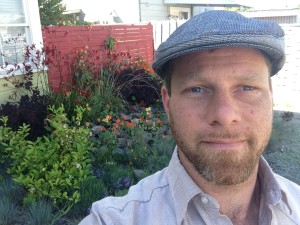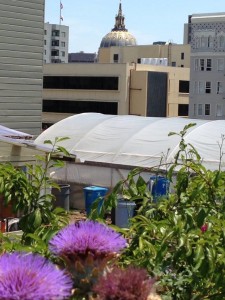The organic food movement is sweeping the nation. Farmers markets are springing up in nearly every county nationwide. Here in Solano County, there are now farmers markets five days per week. The slow food movement is bringing people together at their dinner tables to share homegrown produce. Chefs are now demanding to source their food stuffs direct from regional growers. Victory gardens are making a resurgence as people choose to become beacons of healthy food production in the neighborhood. But what is permaculture?
Permaculture is a way of design that links resources, use and harvest into a connected whole. A complex system of design, permaculture is perfectly suited to community-scale production. By taking into account the local microclimate conditions, permaculture asks how many harvests and functions can be simultaneously realized from one plot of land. It challenges us to shift the foci of our gardens from machine-centric to plant and community centric.
Soil fertility is paramount to healthy produce devoid of synthetic nutrients. Organic farmers spend great amounts of resources to continue to develop the soils in which their crops grow.
“Grow the soil and the soil will grow the plants.”
Healthy soil fertility creates a rich system of resilience that supports healthy plant nutrition. “Grow the soil and the soil will grow the plants.”
However, in a field of just a single crop species, even in the most fecund soil cannot deter all forms of pestilence. Fungus and insects have a field day when that field is all one plant type and thus can make for devastating losses. Conversely, pests can only travel so far when crops are interplanted with other beneficial crops. When we diversify production we create a more resilient system.
Plant Centric- Why do we plant in straight lines? Straight lines are necessary for mechanized agriculture, as machinery operates by the turning of sets of wheels spinning on axels. Thus, straight line agriculture is inherently machine-centric. This makes sense in large scale farm production. However, such “design” is so entrenched in our psyches that many small-plot organic farms implement straight lines even though no machinery is involved. How might we redesign our production fields to become more plant-centric?
Take an organic apple orchard for example, planted in straight lines with nothing but weeds between the rows. Permaculture would ask how we might “stack functions” to increase overall productivity. We could begin by planting the gaps between rows with a second harvest that would tolerate the shade of the apple trees, perhaps Asian greens and peas. Further, we could identify rocky or marginal fringe areas and create there an area for a third harvest of cut flowers flowers that can also serve as a repository for native plants. Such areas can foster a biodiversity of beneficial insects that may assist in pollinating the flowers of the main orchard crop and increase productivity. We also may choose to bring in a herd of animals to overwinter under the fallow trees, eating the winter weed sprouts and depositing fertility into the soil to feed the spring growth of the apples. Animal feces is full of enzymes and positive bacteria that can act to bolster the immune system of the crops we grow while providing an affordable source of organic fertilizer.
Community Centric: Another question to rethink in our production of crops is where are they headed? We can grow 2 acres of carrots and sell them to the regional wholesale buyer and then take a portion of the proceeds to buy other produce. Or we could begin to grow a number of crops that do well in our area and barter with neighbors for other crops we no longer need to buy. Furthermore, if our focus is to have homegrown apples for as much of the year as possible, it may be more productive to plant three to four varieties rather than one, as this spreads out the harvest over several months rather than yielding a ton of apples all at once.
Rethinking Currency: Perhaps at first you can identify a few crops that you can grow well and will soon no longer have to purchase. For example, citrus does well in the bay area, as do berries, culinary herbs and fresh greens. Though certainly not enough to live on, these become home grown foodstuffs you no longer have to spend your currency on. Furthermore, you may be able to barter your lemons and mint for the neighbor’s corn and tomatoes and add to this list of resilience while fostering a culture of interconnectedness. This can begin a community-scale strategy for productivity and interdependence.
Start Now:
-Question: Rethink your lawn: Can I earmark a corner of the lawn for growing crops?
-Observe and Document: What crops do I see at nearby community gardens and farms doing well in my area?
-Organize: Organize a Saturday potluck work-party and work with many hands to make light work. Then the following month rotate to another house and do it again.
-Start small: Start with a manageable amount of production. I recommend a first year goal of chickens, salad greens, culinary herbs, berries and a fruit tree.
-Sow Peas: Follow Henry David Thoreau’s example and plant a patch of peas. Peas and beans add fertility to the soil and are easy to grow. At the end of the season, harvest the bean pods and turn the vegetation into the soil for the following seasons fertility.
-Mulch: Straw or shredded wood chips three to four inches deep on the ground will reduce weeds and retain moisture, while slowly decaying as a food source for the plants and soil.
-Start Now: There is no gift like the present, so begin now. Mistakes made will inform future design.
Joshua Burman Thayer is a landscape designer specializing in drought-tolerant and edible plants. He has designed over 50 Edible Estates around the Bay Area and is engaged to Chelsea Bearce, a Benicia native. Thayer can be found at his website NativeSunGardens.com. You can also follow him on Twitter at @nativesungarden.








Leave a Reply